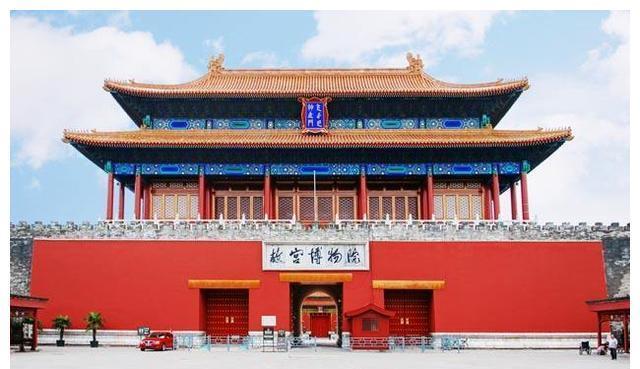The Forbidden City is home to a mountain of treasures and is one of the most famous museums in the world, but at least half of the treasures in the city were left behind by the Qianlong Emperor. Among the treasures of the Qianlong Emperor, there is a very special object called "Halberd", which has the word "fish" in its name, but no one knows where the "fish" is hidden. What's going on here? If you want to know, let Xiaobian reveal the secret for you:

(All pictures in this article, all from the network, thanks to the original author, if you infringe your rights, please contact the author of this number to delete.) The picture has nothing to do with the content, please do not enter the seat)
The Qing Dynasty was the last feudal dynasty in China's history. As a transitional period between ancient and modern times, the unique culture formed by the Qing Dynasty has the significance of carrying forward the upper and lower levels. After the rulers of the Qing Dynasty entered the Central Plains, they used the Forbidden City of the Ming Dynasty as the imperial palace, and since then, treasures from all over the country have been continuously transported to the Forbidden City.
The heyday of the Qing Dynasty was the "Kangqian Prosperous Era", under the management of the Kangxi and Yongzheng emperors, the national treasury reserves began to fill, and the people's material living standards also improved, so by the time of the Qianlong Dynasty, the country's economic and cultural aspects had reached its peak. While enjoying the prosperity of the Taiping Dynasty, the Qianlong Emperor also cultivated his own elegant hobby, he not only liked to chant poetry and paint, but also was keen on collecting. In the treasure house of the Qianlong Emperor, there are not only famous calligraphy and paintings from all over the world, but also exquisite clocks and watches presented by Westerners from thousands of miles away, and various precious utensils specially made by the Ministry of Internal Affairs for him.
The Qianlong Emperor liked to be vassal and elegant, so the names he gave to the treasures in his collection were quite meaningful. However, among the treasures left by the Qianlong Emperor, there is one artifact that is the most puzzling, which is a halberd called "Jiqing Youyu".
What exactly is a "halberd"? The chime is an ancient percussion instrument, mostly made of jade, which produces a crisp and pleasant sound when struck with a wooden mallet, so it is mostly used for court song and dance. The halberd left by the Qianlong Emperor in the Forbidden City is not a percussion instrument, but an ornament, it is 28.3 cm high and 23.1 cm wide, and the top corner has a living ring made of copper variant Shou glyphs, and its supporting assembly is a bat-shaped hook, symbolizing "Fushou Xianghe".
The bracket of the halberd is a square structure, and the border is decorated with a negative engraved echo decoration, a standing tooth ornament and a back pattern. The structure and ornamentation of another supporting halberd are similar to the former, only the body part of the chime is decorated with a double crane holding shou ornament, and the lower part is carved with a bat ribbon, which also has the meaning of "Fushou".
QianlongYe's "Halberd" has a nice name, called -- Jiqing you fish. However, looking at the shape of this "halberd", it seems that it has almost nothing to do with "fish", so why did the Qianlong Emperor name it "fish"? Cultural relics experts have also been troubled by this problem for a long time, until the end, an old expert found the clue when flipping through the "Archives of the Qing Ministry of Internal Affairs", it turned out that "Jiqing has a fish and a fish", and this "fish" is the fish glue used by the ancients to glue utensils.
The "Archives of the Qing Dynasty Ministry of Internal Affairs" records that the material of this "halberd" is not gold and not jade, but fish maw glue. They first make the mold, then pour the melted maw glue into the mold, and soon the frame part of the fish drift glue is made. This "Halberd" was carefully crafted by the craftsmen, and the "Jiqing Youyu Halberd" was successfully made.
It is worth mentioning that cultural relics experts have conducted in-depth research on the cultural relics and tried to use modern means to imitate, but they all failed, the reason is that the boiling method of fish maw glue is not correct, or when the maw glue is boiled, it adds unknown ingredients. Cultural relics experts can not test the national treasure "Jiqing Youyu" halberd, so it is difficult to deeply understand the ancients' know-how of making glue, and this ancient craft cannot be restored, in other words, this glue-making process that embodies the wisdom of Chinese craftsmen has been lost, and the "Jiqing Youyu" halberd has become out of print.
Speaking of this, we have to express regrets, but at the same time, we can also feel pride and pride, ancient craftsmen have left us a number of valuable cultural heritage, they are the essence of Chinese culture, and what we have to do is to do our best to carry it forward and strive to pass it on.